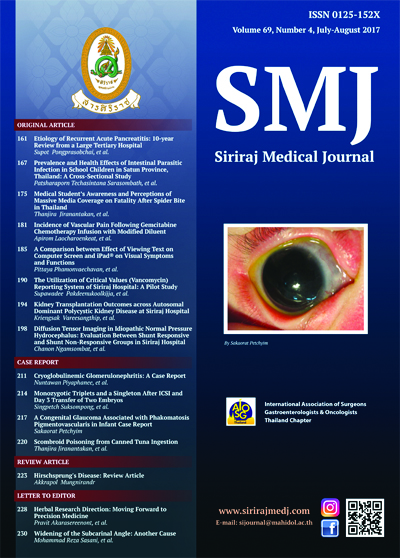A Comparison between Effect of Viewing Text on Computer Screen and iPad® on Visual Symptoms and Functions
Keywords:
Computer vision syndrome, iPad®, eyestrainAbstract
Objective: To compare the ocular symptoms following sustained near vision between laptop computer and iPad®.
Methods: Forty normal subjects read text from a laptop computer screen and an iPad® screen for a continuous 20 min period. Similar text was used in both sessions, which was matched for size and contrast. After finishing viewing text, subjects immediately completed a written questionnaire categorizing symptom scores into three groups: Dry eye, Pain and Blurred vision score. The accommodative amplitude and fusional convergence amplitude at near vision were also assessed before and after reading.
Results: In both conditions, mean symptom scores were higher during iPad use. When comparing the computer and iPad conditions, mean scores were statistically significant different in Pain score (6.30 vs 8.70; p=0.025) and Blurred vision score (10.13 vs 12.03; p=0.041) but no statistically significant difference in Dry eye score (6.30 vs
6.60; p=0.71). There were significant change in accommodative amplitude and fusional convergence amplitude with near vision when compared before and after near-vision tasks in both cases.
Conclusion: Pain and Blurred vision symptoms following sustained iPad use were significantly worse than those reported after computer use under similar viewing conditions. However, both computer screen and iPad cause ocular symptoms having an impact on quality of life.
Downloads
Published
How to Cite
Issue
Section
License
Authors who publish with this journal agree to the following conditions:
Copyright Transfer
In submitting a manuscript, the authors acknowledge that the work will become the copyrighted property of Siriraj Medical Journal upon publication.
License
Articles are licensed under a Creative Commons Attribution-NonCommercial-NoDerivatives 4.0 International License (CC BY-NC-ND 4.0). This license allows for the sharing of the work for non-commercial purposes with proper attribution to the authors and the journal. However, it does not permit modifications or the creation of derivative works.
Sharing and Access
Authors are encouraged to share their article on their personal or institutional websites and through other non-commercial platforms. Doing so can increase readership and citations.











